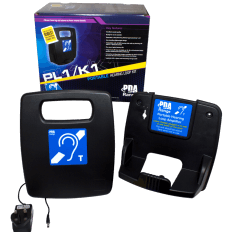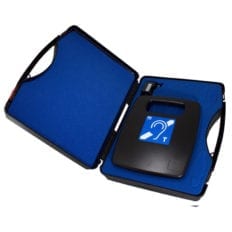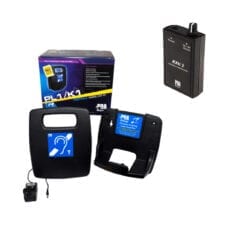BLOG
Home » The Final Assessment: Are Portable Induction Loops Worth It? – Hearing Loop

Introduction to Portable Induction Loops
When considering portable induction loops, as we have compared and contrasted the different areas and applications of fixed versus portable hearing loop systems, it’s easy to see that a portable system does everything a fixed system does and then a whole lot more.
There are a number of areas, from initial costs to the flexibility of use, where portable hearing loop systems come out on top.
While fixed systems remain popular, the trend is very much moving towards portable solutions.
Below, we’ll take you through the various areas where portable hearing loop systems excel and show just why they are the best choice for your business or public space.

Flexibility of Use
A fixed system is, as the name suggests, tied to one area.
If you ever wish to upgrade or change the setup of a fixed system, you will need to bring in a minimum of one technician and prepare for that space to be out of action for at least a day.
If you have multiple rooms with fixed systems, then the disruption compounds.
However, when using a system that includes portable induction loops, with their modular and moveable elements, these portable systems do not suffer from these issues.
If you need to provide coverage for another area of your business, you can simply move the portable hearing loop components and set them up in less than ten minutes. If you have multiple rooms with portable hearing loop systems, you can move them, split them and basically do whatever you need to do to provide the best coverage.
This means any visitor or employee with hearing difficulty will always have access to a hearing loop system, whether it’s in a training room, boardroom or even outside.
This level of flexibility simply is not possible with a fixed hearing loop system.
-
Offer!

PL1/K1 Portable Hearing Loop & Shelf (1.2m2)
£233.00£149.00 exl VATSaving £84.00 each exl VAT
SKU: PL1/K1
Add to cart -
Offer!

PL1/K3 Portable Hearing Loop & Carry Case (1.2m2)
£336.00£215.00 exl VATSaving £121.00 each exl VAT
SKU: PL1/K3
Add to cart -

PL1/K1 SSB Portable Hearing Loop Self Service Bundle
£199.00 exl VATSKU: PL1/K1 SSB
Add to cart
Functionality
Most businesses, when given the option, will always go for the option that gives them the widest range of uses – and this is where portable hearing loop systems excel.
Even the simplest set up can afford a wide range of functionality and applications, making it easy for the user to function as they need within your business, while also giving you the agility to meet multiple needs for hearing impaired clients and customers.
The national charity, Action on Hearing Loss estimates that by 2035, one in five people in the UK will have some form of hearing loss, meaning the need for a hearing loop system is only set to increase.
The Phonak Roger Pen system – a type of portable hearing loop set up – uses just one microphone, but offers multiple uses and applications, delivering superb functionality without any of the operational or logistical restrictions of a fixed system. With a Roger Pen, the user can point it at a specific person and the pen functions as a directional microphone, picking up only the noise source the user wants.
When placed on its side, the pen becomes an omni-directional microphone.
This means the user, with just one device, can then hear the wider audio atmosphere around them.
And that still isn’t the end of the Roger Pen’s usefulness.
When placed in a docking station, the pen can connect to a number of audio inputs – television, presentations, PA systems – and fulfil that role as well, making it useful for conference and meeting venues, larger commercial organisations and educational and healthcare facilities.
Installation
When it comes to getting your hearing loop system up and running, a portable option wins hands-down.
A fixed hearing loop system will cost between £700-£1500 per-room, depending on the size of the space.
In contrast, a system that comprises of two-pack portable induction loops will cost around £800, but it’s in the installation phase and beyond that you will be the savings.
A portable hearing loop system is truly plug in and play, whereas a fixed system requires extensive installation, including cabling.
If you require a room to be contained and overspill into other nearby spaces, the price of installation can rise to match the increased work needed to make this happen.
In the final measure, a portable induction loops system is much quicker to install, causes far less disruption and provides better value over its lifetime than a fixed hearing loop system.

Future Proofing
With the above in mind, it’s important to look at the long-term savings and costs of portable and fixed hearing loop systems.
A portable induction loop system is easy to add to and upscale.
All you need to do is add more modular additions and, if need be, add something like a Phonak Digimaster, which acts as both a speaker and PA system and eliminates the need to double up on microphones.
Unlike a fixed system, if you move premises you can take your portable induction loops system with you – simply unhook it and go.
This means your initial investment keeps paying dividends even in a new business space, whereas a fixed system must be left behind.
That means having to invest again in the same system and, if you move in the future, repeating the whole process once more. It’s also worth bearing in mind the maintenance costs associated with your chosen system, as these form part of the overall expenditure you’re going to make.
For a fixed system, you will probably have to spend about £640 for maintenance across three rooms – the more rooms you have with a system, the more expensive it will be.
A portable hearing loop system, which requires very little maintenance, will cost around £50 for a technician’s visit and the process is a quick one.
In the final appraisal, portable hearing loop systems provide more flexibility, better future proofing for your investment, lower overall costs and, ultimately, a better, more agile hearing loop system.
Download our comprehensive portable hearing loop systems guide here or contact us to find out how we can help you find the right system.
Call 0114 2357 717 or email us at info@hearingloop.co.uk to get connected to one of our hearing loop experts.
Categories
- Assisted Living (3)
- Communication (4)
- Compliance (2)
- Cordless Telephones (3)
- Design Survey (1)
- Features & Benefits (1)
- Features & Benefits (1)
- General Hearing (4)
- Hearing Loop Systems (14)
- Hearing Loop Uses (4)
- Hearing Loops (29)
- Installation & Commissioning (3)
- Installation & Commissioning (1)
- Portable Hearing Loop (3)
- Portable Hearing Loops (15)
- Service & Maintenance (2)
- Service & Maintenance (1)
- Uncategorized (2)
Recent Posts
- 10 Remarkable Benefits of Using the PL1/K1 Portable Hearing Loop System
- The Ultimate Guide to Phonak Roger ON: How It Works and Who It’s For
- The PL1/K1 Portable Hearing Loop: A Game-Changer for Midwives and Community Healthcare Providers
- Future Proofing Your Portable Hearing Loop System Investment
- What is Hearing Loop Technology?




